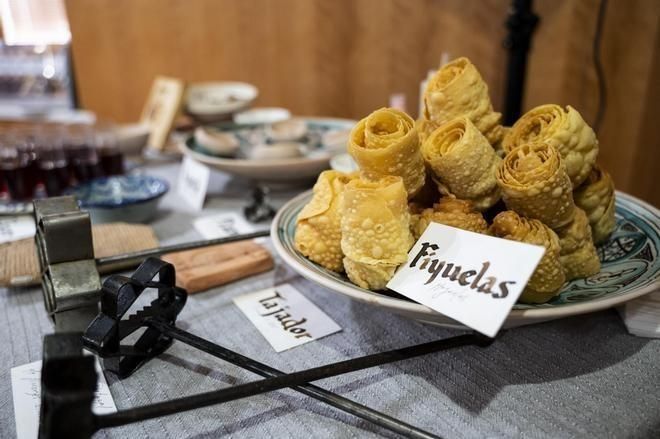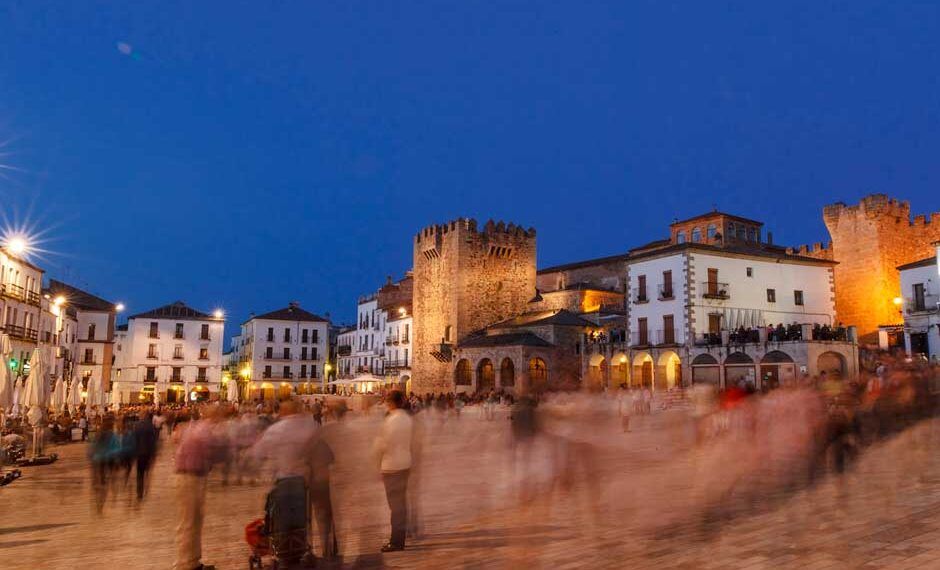As the sun dips low over Cáceres, a medieval city in the north of Spain’s Extremadura region, its crenellated skyline softens into warm stone. Nestled between rolling hills and olive groves, Cáceres is a place where history lingers in every street and plaza. You climb the spiral staircase of the Baluarte de los Pozos, a tower-fortress overlooking the whitewashed lanes of the old Judería, until you reach a small chamber where glass bowls capture glints of amber and citrus. The scent is immediate — honey, orange, and something ancient, like a memory that has been sleeping in the shadows.
This is “Sabores y Aromas de Sefarad”, an exhibition that does more than preserve Sephardic heritage: it resurrects it through taste. Curated by chef-historian Javier Zafra, the show turns biblical foods — figs, pomegranates, olives, wheat, barley, honey — into a tactile journey. These ingredients, once staples of medieval Jewish life, are not displayed behind glass. Instead, they feel alive: aromatic, edible, meaningful.
 Zafra leads the visitor into stories. Take the honey: not just a sweetener, but a metaphor — divine sweetness, resilience, continuity. The pomegranate seeds glisten like rubies and stand for righteousness; wheat and barley speak of fragility and renewal, their grains a quiet reminder of the precariousness of diasporic life.
Zafra leads the visitor into stories. Take the honey: not just a sweetener, but a metaphor — divine sweetness, resilience, continuity. The pomegranate seeds glisten like rubies and stand for righteousness; wheat and barley speak of fragility and renewal, their grains a quiet reminder of the precariousness of diasporic life.
But it’s the sweets that whisper the loudest. Thin ribbons of candied citrus peel hint at remedies for childbirth. Almond pastries embossed with geometric patterns echo Jewish decorative traditions. Herbal infusions fill the room with soft resonance — medicine and ritual folded into one.
The sensory experience does not end within the tower. As part of the Red de Juderías’ RASGO program (Red de Juderías), local restaurants reinterpret Sephardic recipes with contemporary flair. Visitors can taste rice stews in olive oil, almond soups, honeyed pastries, and other dishes that once traveled from Andalusia to the Ottoman Empire, now reborn in Extremadura.
Seasonal events, including the European Day of Jewish Culture, bring theatrical walks, storytelling, and music to the Juderías, allowing visitors to immerse themselves in the city’s multicultural past. The city’s streets themselves offer sensory rewards: a narrow alley, a cool stone façade, a hidden courtyard, or the view from the Baluarte terrace at twilight, where rooftops of terracotta and defensive towers stretch beneath the fading light.
 A City of Two Juderías
A City of Two Juderías
Cáceres’ Jewish community played a significant role in shaping the city long before the expulsions of 1492. From the Middle Ages onward, Jews in Cáceres were merchants, scholars, and artisans who contributed to the city’s economy and cultural life. Their presence left an indelible mark on the urban fabric, with two historic Jewish quarters, each with a distinct personality, still visible today.
The Judería Vieja, clustered around the church of San Antonio, is a medieval labyrinth of narrow streets, whitewashed homes, low arches, and hidden patios. Walking these streets, it is easy to imagine the lives of conversas and Jews who once lived here, praying in private, studying, trading, and maintaining their traditions under the watchful eye of changing regimes. The Arco del Cristo, a silent sentinel of centuries past, evokes the weight of that history, its stone archway framing a world where faith and daily life intertwined under the shadow of both tolerance and restriction.
Across the city, the Judería Nueva unfolds more expansively. Centered on the Palacio de la Isla, this quarter preserves the memory of a synagogue believed to have once stood on or near its foundations. Here, the streets whisper stories of families who navigated the complexities of life in a medieval Christian city, retaining knowledge, language, and culinary traditions even as the tides of history threatened to erase them. These quarters were not isolated; they were integrated into the broader civic and economic life of Cáceres, contributing to its identity as a vibrant, multi-layered city.
Beyond its Jewish heritage, Cáceres is celebrated for its Renaissance and Gothic palaces, such as the Palacio de los Golfines de Abajo, whose elegant façades and courtyards convey the wealth and influence of noble families. The Palacio de Carvajal hosts exhibitions that explore regional history, often highlighting the Sephardic legacy and the cultural exchanges that shaped the city. Religious and civic architecture further testifies to the layers of history: the Concatedral de Santa Mara, built on the site of a former mosque, reflects the city’s complex spiritual past. The Arco de la Estrella frames the Old Town and invites visitors to step into centuries of urban life, where Christian, Muslim, and Jewish traditions converged.
Wandering through hidden gardens, tranquil courtyards, and quiet plazas, travelers can pause to reflect on the interplay of memory, architecture, and daily life. In Cáceres, heritage is not confined to monuments. It lives in the narrow alleys, in the lingering aromas of traditional recipes, and in the rhythm of a city that has absorbed centuries of human experience while keeping the memory of its Sephardic past alive.









